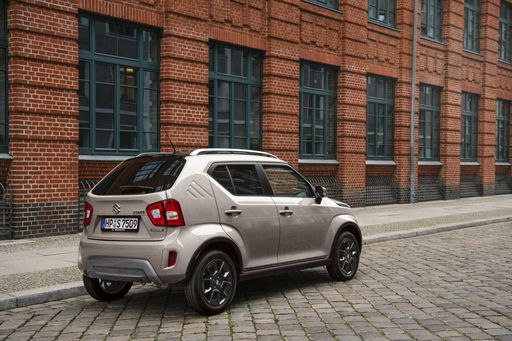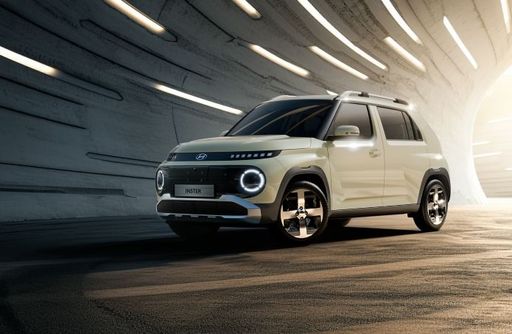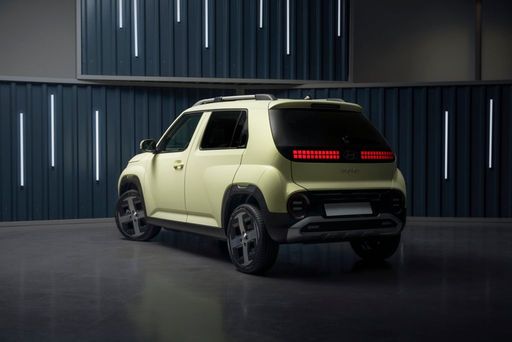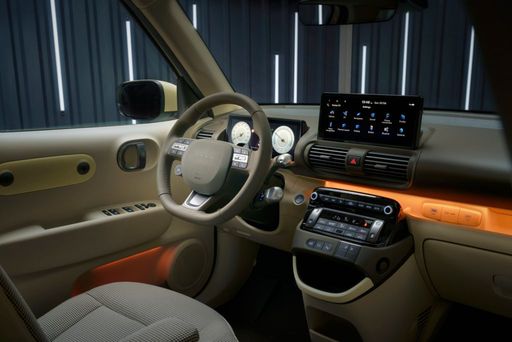The automotive landscape is evolving rapidly, especially in the realm of compact SUVs. In this article, we compare two distinctive models: the Suzuki Ignis and the Hyundai Inster. Each vehicle offers unique advantages and appeals to different driver preferences. Let’s dive into the technical aspects and innovations that define these contenders in the compact SUV market.
Suzuki Ignis vs Hyundai Inster – Performance, range & efficiency compared
Compare performance, boot capacity, efficiency and price at a glance.
Find out which car is the better choice for you – Suzuki Ignis or Hyundai Inster?
Model Overview
The Suzuki Ignis, a compact SUV introduced in 2020, is celebrated for its practicality and agile handling, making it a favorite for urban drivers. On the other hand, the Hyundai Inster, set to debut in 2025, represents a shift toward sustainable travel, showcasing Hyundai's commitment to electric mobility.
Engine & Transmission
The Suzuki Ignis comes equipped with a petrol MHEV (Mild Hybrid Electric Vehicle) engine, offering two transmission options: a manual gearbox and a CVT automatic. Producing 83 HP and 107 Nm of torque, it provides efficient performance with a fuel consumption ranging from 4.9 to 5.4 L/100 km, depending on driving conditions.
In contrast, the Hyundai Inster is solely an electric vehicle, featuring a powertrain capable of delivering between 97 to 115 HP and a robust torque of 147 Nm. Its automatic reduction gearbox promises smooth, responsive acceleration, and with power consumption measured at 14.3 to 15.1 kWh/100 km, it presents a sustainable alternative for eco-conscious drivers.
Performance and Acceleration
In terms of acceleration, the Ignis takes approximately 12.7 seconds to reach 100 km/h, a respectable figure for its class. Its maximum speed reaches 165 km/h, making it suitable for both urban commutes and occasional highway journeys.
The Inster, on the other hand, features an impressive acceleration time of 10.6 seconds, showcasing its electric performance capabilities. With a max speed of 150 km/h, it is well-equipped for modern driving demands, especially within city limitations.
Dimensions and Design
The Suzuki Ignis measures 3700 mm in length, 1690 mm in width, and stands at a height of 1605 mm. This compact size makes it nimble on city streets while providing a decent trunk capacity of 267 L.
In comparison, the Hyundai Inster is slightly larger, measuring between 3825 and 3845 mm in length, and 1610 mm in width. Despite its bulkier dimensions, it offers a practical trunk capacity of up to 280 L, ideal for daily errands and weekend getaways.
Battery and Electric Range
A notable advantage of the Inster lies in its electric capabilities, featuring battery capacities ranging from 42 to 49 kWh. This translates to an impressive electric range of up to 370 km, ensuring the vehicle is fully prepared for longer trips without the anxiety of frequent charging stops.
In contrast, the Ignis, reliant on traditional fuel, does not have the range limitations inherent to combustion engines but offers a fuel tank capacity of 32 liters, providing reasonable range on a full tank for urban utilization.
Environmental Considerations
In the realm of emissions, the Suzuki Ignis falls within B-C efficiency classes, with CO2 emissions ranging from 110 to 122 g/km. While it certainly is more efficient than many vehicles, it cannot match the Inster's zero emissions, as it operates fully on electric power, classified as A in terms of CO2 efficiency.
Final Thoughts
Choosing between the Suzuki Ignis and the Hyundai Inster ultimately depends on one’s driving needs and preferences. The Ignis is a solid choice for those seeking a compact, fuel-efficient SUV with a mild hybrid option. In contrast, the Inster appeals to eco-friendly consumers looking to transition to electric mobility without compromising on style or functionality.
Both models showcase their manufacturers' commitment to innovation, albeit in different directions. As the automotive industry shifts toward sustainability, the choice between these two distinct vehicles points to the future of urban driving.
Here’s where it gets real: The technical differences in detail
Costs and Efficiency:
When it comes to price and running costs, the biggest differences usually appear. This is often where you see which car fits your budget better in the long run.
Suzuki Ignis has a evident advantage in terms of price – it starts at 15600 £, while the Hyundai Inster costs 20500 £. That’s a price difference of around 4877 £.
Engine and Performance:
Power, torque and acceleration are the classic benchmarks for car enthusiasts – and here, some clear differences start to show.
When it comes to engine power, the Hyundai Inster has a evident edge – offering 115 HP compared to 83 HP. That’s roughly 32 HP more horsepower.
In acceleration from 0 to 100 km/h, the Hyundai Inster is a bit quicker – completing the sprint in 10.60 s, while the Suzuki Ignis takes 12.70 s. That’s about 2.10 s faster.
In terms of top speed, the Suzuki Ignis performs barely noticeable better – reaching 165 km/h, while the Hyundai Inster tops out at 150 km/h. The difference is around 15 km/h.
There’s also a difference in torque: Hyundai Inster pulls clearly perceptible stronger with 147 Nm compared to 107 Nm. That’s about 40 Nm difference.
Space and Everyday Use:
Beyond pure performance, interior space and usability matter most in daily life. This is where you see which car is more practical and versatile.
Seats: Suzuki Ignis offers slightly more seating capacity – 5 vs 4.
In curb weight, Suzuki Ignis is significantly lighter – 935 kg compared to 1380 kg. The difference is around 445 kg.
In terms of boot space, the Hyundai Inster offers slight more room – 280 L compared to 267 L. That’s a difference of about 13 L.
In maximum load capacity, the Suzuki Ignis performs hardly perceptible better – up to 1100 L, which is about 41 L more than the Hyundai Inster.
When it comes to payload, Suzuki Ignis barely noticeable takes the win – 395 kg compared to 357 kg. That’s a difference of about 38 kg.
Who wins the race?
The Suzuki Ignis proves to be barely ahead and therefore becomes our DriveDuel Champion!
Suzuki Ignis is the better all-rounder in this comparison.
 @ Suzuki Motor Corporation
@ Suzuki Motor Corporation
Suzuki Ignis
Suzuki Ignis
The Suzuki Ignis is a cheeky compact crossover that turns city chores into cheerful adventures, with chunky styling and a surprisingly practical cabin. It won't pretend to be a sports car, but its nimble manners, low running costs and ample personality make it an ideal pick for urban buyers who want fun without pretension.
details @ Suzuki Motor Corporation
@ Suzuki Motor Corporation
 @ Suzuki Motor Corporation
@ Suzuki Motor Corporation
 @ Suzuki Motor Corporation
@ Suzuki Motor Corporation
 @ Suzuki Motor Corporation
@ Suzuki Motor Corporation
 @ Suzuki Motor Corporation
@ Suzuki Motor Corporation
Hyundai Inster
The Inster has quickly captured the attention of automotive enthusiasts with its striking design and dynamic performance. This model seamlessly blends advanced technology with comfort, making it an ideal choice for both daily commutes and adventurous road trips. With its spacious interior and innovative features, the Inster promises an exhilarating driving experience that doesn’t compromise on practicality.
details @ Hyundai Motor Company
@ Hyundai Motor Company
 @ Hyundai Motor Company
@ Hyundai Motor Company
 @ Hyundai Motor Company
@ Hyundai Motor Company
 @ Suzuki Motor Corporation
@ Suzuki Motor Corporation
|
 @ Hyundai Motor Company
@ Hyundai Motor Company
|
|
|
|
Costs and Consumption |
|
|---|---|
|
Price
15600 - 19500 £
|
Price
20500 - 25800 £
|
|
Consumption L/100km
4.9 - 5.4 L
|
Consumption L/100km
-
|
|
Consumption kWh/100km
-
|
Consumption kWh/100km
14.3 - 15.1 kWh
|
|
Electric Range
-
|
Electric Range
327 - 370 km
|
|
Battery Capacity
-
|
Battery Capacity
42 - 49 kWh
|
|
co2
110 - 122 g/km
|
co2
0 g/km
|
|
Fuel tank capacity
30 - 32 L
|
Fuel tank capacity
-
|
Dimensions and Body |
|
|---|---|
|
Body Type
SUV
|
Body Type
SUV
|
|
Seats
4 - 5
|
Seats
4
|
|
Doors
5
|
Doors
5
|
|
Curb weight
935 - 995 kg
|
Curb weight
1380 - 1433 kg
|
|
Trunk capacity
204 - 267 L
|
Trunk capacity
238 - 280 L
|
|
Length
3700 mm
|
Length
3825 - 3845 mm
|
|
Width
1690 mm
|
Width
1610 mm
|
|
Height
1605 mm
|
Height
1575 - 1610 mm
|
|
Max trunk capacity
1086 - 1100 L
|
Max trunk capacity
1059 L
|
|
Payload
335 - 395 kg
|
Payload
317 - 357 kg
|
Engine and Performance |
|
|---|---|
|
Engine Type
Petrol MHEV
|
Engine Type
Electric
|
|
Transmission
Manuel, Automatic
|
Transmission
Automatic
|
|
Transmission Detail
Manual Gearbox, CVT
|
Transmission Detail
Reduction Gearbox
|
|
Drive Type
Front-Wheel Drive, All-Wheel Drive
|
Drive Type
Front-Wheel Drive
|
|
Power HP
83 HP
|
Power HP
97 - 115 HP
|
|
Acceleration 0-100km/h
12.7 - 12.8 s
|
Acceleration 0-100km/h
10.6 - 11.7 s
|
|
Max Speed
155 - 165 km/h
|
Max Speed
140 - 150 km/h
|
|
Torque
107 Nm
|
Torque
147 Nm
|
|
Number of Cylinders
4
|
Number of Cylinders
-
|
|
Power kW
61 kW
|
Power kW
71 - 85 kW
|
|
Engine capacity
1197 cm3
|
Engine capacity
-
|
General |
|
|---|---|
|
Model Year
2020
|
Model Year
2025
|
|
CO2 Efficiency Class
C, D
|
CO2 Efficiency Class
A
|
|
Brand
Suzuki
|
Brand
Hyundai
|
What drive types are available for the Suzuki Ignis?
The Suzuki Ignis is offered with Front-Wheel Drive or All-Wheel Drive.
The prices and data displayed are estimates based on German list prices and may vary by country. This information is not legally binding.
